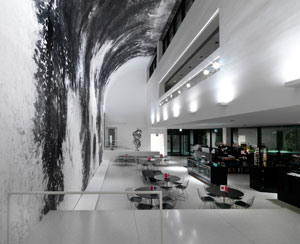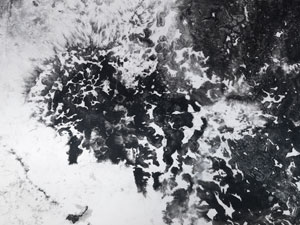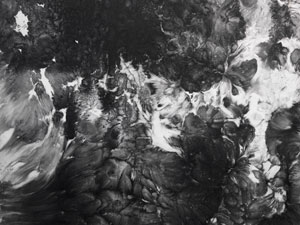Art flow
The largest-ever ink-on-rice-paper painting brings new art to the Smart Museumís threshold.
By Amy Braverman Puma
Photography by Tom Van Eynde

Cascade puts a spotlight on the Smartís concave wall.
Walk into the Smart Museum these days, and you can’t help but notice, perhaps for the first time, that the back wall of the reception hall (where the café tables sit) curves at the top. Accentuating the curve is an installation put up in mid-November, curated by art-history professor Wu Hung. Covering the entire 52-by-41-foot wall, the abstract, black-and-white landscape suggests water and fire flowing downward—or is it upward?—in smooth waves.
The first commission in the museum’s Threshold series, Cascade will adorn the wall through next December, says Smart Museum director Tony Hirschel. Viewers can gaze at it from the café tables or lie on a futon brought in so people can look up at that concave wall and ponder the waves, splotches, and trickles. They can inspect the crinkly rice paper that artist Bingyi painted this summer on a Chinese basketball court, where it was so hot she could work only at night, Hirschel says, and where a windstorm ripped some of the panels, which Bingyi reinforced with more rice paper. She experimented with kitchen detergent and bathroom cleaner to see how the chemicals would alter the ink’s absorption into the paper (see details).


The artist used chemicals to see how the ink would absorb differently into the paper.
After the panels were shipped to Chicago, Bingyi oversaw their installation. A Smart Museum crew affixed the sheets to the wall with wheat paste, creating what is thought to be the largest rice-paper ink painting ever made. It’s an impressive sight, although, over the winter, not much of a visual respite from the whites and grays outside; at least the black provides coffee drinkers some contrast to behold, unlike the whitewashed outdoor environs.
Cascade is only one sign of the Smart’s leap into Chinese art: along with Chinese-born, American-educated Bingyi’s modern piece, the museum explores China’s ancient Buddhist caves in Echoes of the Past, an exhibit that runs through January 16 (see “Original Source,” Investigations) and makes visitors feel as if they are inside the intricate, sculpted cave temples.
As for me, when the holidays are over and I’m feeling the winter sting, I plan to grab a latte, plop down on that futon, and gaze up at those rice-paper waves.
